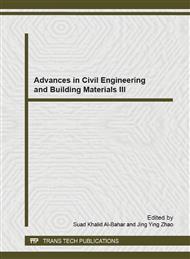p.354
p.359
p.364
p.370
p.376
p.380
p.387
p.393
p.401
The Effects of Expansive Additive on Rapid Hardening Cement Grout for Semi-Rigid Pavement
Abstract:
Semi-rigid pavement, which mitigates the drawbacks of cement concrete and asphalt concrete pavements, is being widely used, but the body of research on enhancing the performance of cement grout remains limited. This paper discusses basic research on the development of a rapid hardening cement grout for semi-rigid pavement that meets chloride resistance, rheological property, and strength requirements. Evaluation results indicate that with up to 10% addition of expansive additive, in terms of the weight fraction of cement particles, the rheological property and strength requirements were satisfied. Examination of the chlorine ion penetration resistance revealed that an increase of expansive additive content yielded lower numbers of charged chlorine ions, resulting in 75.5 times higher resistance over a plain mix designed without expansive additive. In contrast, it was found that excessive addition of expansive additive, that is, beyond 10% in terms of the weight fraction of cement particles, was detrimental to achieving the desired rheological property.
Info:
Periodical:
Pages:
376-379
Citation:
Online since:
December 2013
Authors:
Price:
Сopyright:
© 2014 Trans Tech Publications Ltd. All Rights Reserved
Share:
Citation:


